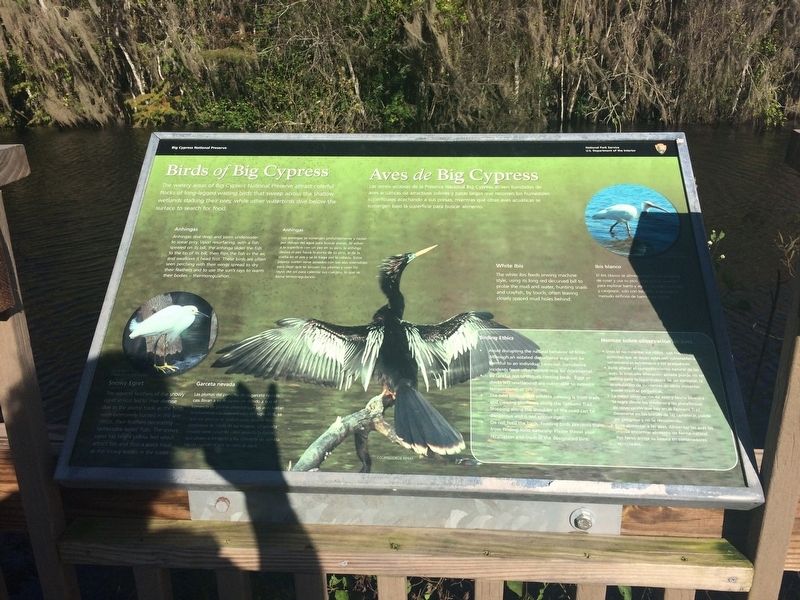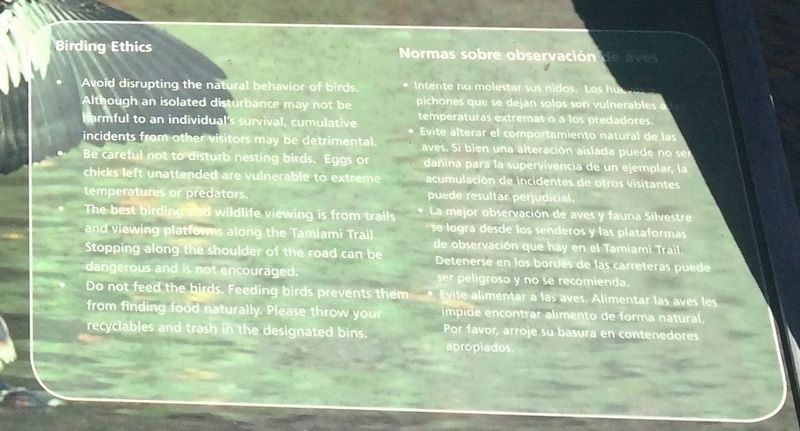Birds of Big Cypress
Anhingas
Anhingas dive deep and swim underwater to spear prey. Upon resurfacing, with a fish speared on its bill, the anhinga slides the fish to the tip of its bill, then flips the fish in the air, and swallows it head first. These birds are often seen perching with their feathers and to use the sun's rays to warm their bodies-thermoregulation.
Snowy Egret
The aigrette feathers of the snowy egret almost led to their demise due to the plume trade as the birds were extensively hunted in the late 1800s, their feathers decorating fashionable ladies' hats. The snowy egret has bright yellow feet which attracts fish and thus a quick meal as the snowy wades in the water.
White Ibis
The white ibis feeds sewing machine style, using its long red decurved bill to probe the mud and water, hunting snails and crayfish, by touch, often leaving closely spaced mud holes behind.
Birds Ethics
• Avoid disrupting the natural behavior of birds. Although an isolated disturbance may not be harmful to an individual's survival, cumulative incident from other visitors
• Be careful not to disturb nesting birds. Eggs or chicks left unattended are vulnerable to extreme temperatures or predators.
.The best birding and wildlife viewing is from trails and viewing platforms along the Tamiami Trail.
• Do no feed the birds. Feeding birds prevents them from finding food naturally. Please throw your recyclables and trash in the designated bins.
Erected by Big Cypress National Preserve/ Everglade Park Service U. S. Department of the Interior.
Topics. This historical marker is listed in these topic lists: Animals • Environment • Horticulture & Forestry.
Location. 25° 51.491′ N, 81° 2.009′ W. Marker is in Ochopee, Florida, in Collier County. Marker is on 33100 Tamiami Trail East. Marker is located in Big Cypress Park. Touch for map. Marker is in this post office area: Ochopee FL 34141, United States of America. Touch for directions.
Other nearby markers. At least 7 other markers are within 5 miles of this marker, measured as the crow flies. Wildlife & You (a few steps from this marker); H. P. Williams Roadside Park (within shouting distance of this marker); Big Cypress National Preserve (within shouting distance of this marker); Fighting an Invasion (within shouting distance of this marker); Big Cypress (about 300 feet away, measured in a direct line); Stephen Tyng Mather (about 300 feet away); 1936 Seminole Conference (approx. 5 miles away).
Also see . . .
1. Snowy Egret. Habitat They are most common along the coast, though they do breed patchily in inland wetlands. Snowy Egrets nest colonially, usually on protected islands, and often with other small herons. They concentrate on mudflats, beaches, and wetlands, but also forage in wet agricultural fields and along the edges of rivers and lakes. (Submitted on July 28, 2017, by Sandra Hughes Tidwell of Killen, Alabama, USA.)
2. Anhinga. A bird of southern swamps, the Anhinga is known as the Water-Turkey for its swimming habits and broad tail, and also as the Snake-Bird for its habit of swimming with just its long head and neck sticking out of the water. (Submitted on July 28, 2017, by Sandra Hughes Tidwell of Killen, Alabama, USA.)
3. White Ibis. (Submitted on August 2, 2017, by Bill Pfingsten of Bel Air, Maryland.)
Credits. This page was last revised on August 2, 2017. It was originally submitted on July 28, 2017, by Sandra Hughes Tidwell of Killen, Alabama, USA. This page has been viewed 199 times since then and 8 times this year. Photos: 1, 2. submitted on July 28, 2017, by Sandra Hughes Tidwell of Killen, Alabama, USA. • Bill Pfingsten was the editor who published this page.

